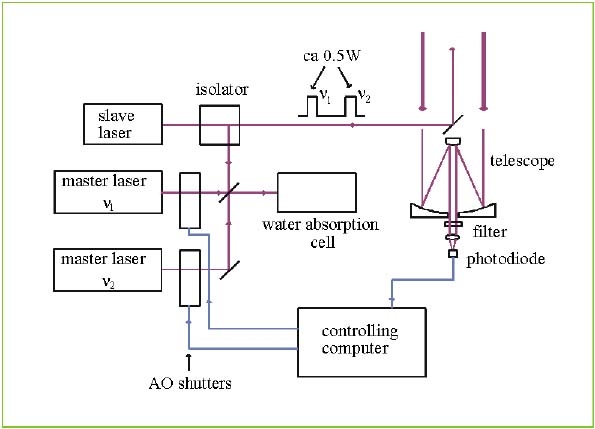A Low-cost Differential Absorption Lidar For Measuring Tropospheric Water Vapour Concentration
K-H. Bae, M.W. Hamilton and R.A. Vincent
Optics and Atmospheric Physics research groups,
Physics and Mathematical Physics ,
Adelaide University , Adelaide, SA5005
![]()
We are developing a lidar for measuring the profile of water
vapour concentration in the lowest 4km of the atmosphere.
This will provide data on the atmospheric gas that is most responsible
for the greenhouse effect and the weather.
The lack of accurate and reliable data on water vapour concentration in the lower troposphere hampers both scientific and applied studies of the atmosphere. The data gathered by current techniques is too sparse and infrequent for weather and climate models.
Semi-real-time measurements of the variability will help greatly in weather forecasting, prediction of fog and hydrology. At present, such measurements are mainly made by balloon sonde, which has high recurrent costs and is limited in geographical and temporal coverage.
DIfferential Absorption Lidar (DIAL).
How it works ...
- Pulses of laser light are produced at 2 wavelengths with equal intensity
- One wavelength is tuned to water vapour absorption resonance ...
the ther is tuned a small way from this where there is no absorption. - Light scatters from molecules and aerosols in the atmosphere with more or less equal probability for each wavelength
- Scattered light at one wavelength inherently less intense than the other because that wavelength has also been absorbed by water in the beam path.
- From the ratio of back-scattered power detected at the two wavelengths, water vapour density can be inferred.
Our Device
- Wavelength range around 830nm (3n + d polyad).
- (Other suitable wavelengths are around 720nm but there are no diode lasers there. )
- Pulse length ~500ns (initially) giving range resolution ~200m.
- Expected sensitivity at 4km range with 0.5W pulses is about 0.5g/kg (water vapour mixing ratio)
- Optical package (excl. telescope) should fit into 20 litre volume.

A diagram showing the optical aspects of our planned lidar.
Optical issues to be dealt with:
- Slave laser is to be pulsed synchronously with master pulses - will chirping be a problem?
- Would a tapered amplifier be better? too much amplified spontaneous emission? too expensive?
- How is laser frequency difference (~10GHz) to be maintained?
Complementary techniques:
- GPS: Analysis of signals from Global Positioning System satellites can provide data on integrated column densities of water vapour.
- Spaceborne Lidar: The WALES collaboration aims to build a spaceborne system (lambda = 940nm) to measure stratospheric water vapour densities.
- Other ground-based lidars have been built, but are based on Ti:sapph lasers (expensive! but give greqter range)
- One other known diode based system under construction at NOAA (see Machol et al. 1998 - reference below)
References
Machol, J. L., R. M. Hardesty, J. B. Abshire, M. A. Krainik, G. W. Switzer,
D. M. Cornwell, and M. A. Randall,
Development of a miniature water vapor DIAL system,
in Proceedings of
Fourth International Symposium on Tropospheric Profiling: Needs and
Technologies, Snowmass, Colorado, September 21-25, 212-214, 1998.
... and a useful general reference
Wulfmeyer, V., and J. Bosenberg,
Ground-based differential absorption lidar for water-vapor profiling: Assessment of
accuracy, resolution and meteorological applications,
Applied Optics, 1999.
Mail comments to mwh@physics.adelaide.edu.au
last update 12/12/01